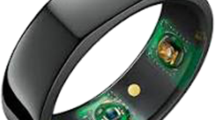Abstract
Purpose
The purpose of this study is to determine the optimal scoring method and parameter settings of actigraphy by comparison to simultaneous polysomnography (PSG).
Methods
Fifteen studies of simultaneous PSG and actigraphy were completed in adolescents (mean age = 16.3 years) and analyzed. Scoring actigraphy by the human eye was compared to a commercial computerized algorithm using various parameters. The PSG was considered the reference standard.
Results
There was a better correlation between actigraphy and PSG sleep start/end, total sleep time, wake after sleep onset, and sleep efficiency when the rest period was determined by the human (mean r = 0.640) rather than auto-set by the software (r = 0.406). The best results came when the rest intervals were set based on the PSG (r = 0.694). Scoring the printed actogram by the human eye was superior to the auto analyses as well (r = 0.575). Higher correlations and lower biases were obtained from lower wake threshold settings (low and medium) and higher immobility times (10 and 15 min).
Conclusions
Visual scoring by simple inspection of the actigraphy tracing had a reasonable correlation with the gold standard PSG. Accurate determination of the rest interval is important in scoring actigraphy. Scoring actigraphy by the human eye is superior to this computer algorithm when auto-setting major rest periods. A low wake threshold and 10–15 min of immobility for sleep onset and sleep end yield the most accurate computerized results. Auto-setting major rest intervals should be avoided to set start/end of rest intervals; adjustments for artifacts and/or a sleep diary for comparison are helpful.

Similar content being viewed by others
References
Sadeh A, Acebo C (2002) The role of actigraphy in sleep medicine. Sleep Med Rev 6:113–124
Littner M, Kushida CA, Anderson WM, Bailey D, Berry RB, Davila DG, Hirshkowitz M, Kapen S, Kramer M, Loube D, Wise M, Johnson SF (2003) Practice parameters for the role of actigraphy in the study of sleep and circadian rhythms: an update for 2002. Sleep 26:337–341
Collop NA, Anderson WM, Boehlecke B, Claman D, Goldberg R, Gottlieb DJ, Hudgel D, Sateia M, Schwab R (2007) Clinical guidelines for the use of unattended portable monitors in the diagnosis of obstructive sleep apnea in adult patients. Portable monitoring task force of the American academy of sleep medicine. J Clin Sleep Med 3(7):737–747
Acebo C, LeBourgeois MK (2006) Actigraphy. Respir Care Clin N Am 12(1):23–30, viii
Ancoli-Israel S, Cole R, Alessi C, Chambers M, Moorcroft W, Pollak CP (2003) The role of actigraphy in the study of sleep and circadian rhythms. Sleep 26:342–392
Morgenthaler T, Alessi C, Friedman L, Owens J, Kapur V, Boehlecke B, Brown T, Chesson A, Coleman J, Lee-Chiong T, Pancer J, Swick TJ (2007) Practice parameters for the use of actigraphy in the assessment of sleep and sleep disorders: an update for 2007. Sleep 30:519–529
Iber C, Ancoli-Israel S, Chesson AL Jr, Quan SF (2007) The AASM manual for the scoring of sleep and associated events: rules, terminology, and technical specifications. American Academy of Sleep Medicine, Westchester
Bland JM, Altman DG (1986) Statistical methods for assessing agreement between two methods of clinical measurement. Lancet 1:307–310
de Souza L, Benedito-Silva AA, Nogueira Pires ML, Poyares D, Tufik S, Calil HM (2003) Further validation of actigraphy for sleep studies. Sleep 26:81–85
Chae KY, Kripke DF, Poceta JS, Shadan F, Jamil SM, Cronin JW, Kline LE (2009) Evaluation of immobility time for sleep latency in actigraphy. Sleep Med 10:621–625
Kim MJ, Lee GH, Kim CS, Kim WS, Chung YS, Chung S, Lee SA (2012) Comparison of three actigraphic algorithms used to evaluate sleep in patients with obstructive sleep apnea. Sleep Breath. doi:10.1007/s11325-012-0689-z
Paquet J, Kawinska A, Carrier J (2007) Wake detection capacity of actigraphy during sleep. Sleep 30:1362–1369
Kripke DF, Hahn EK, Grizas AP, Wadiak KH, Loving RT, Poceta JS, Shadan FF, Cronin JW, Kline LE (2010) Wrist actigraphic scoring for sleep laboratory patients: algorithm development. J Sleep Res 19(4):612–619
Montgomery-Downs HE, Insana SP, Bond JA (2011) Movement toward a novel activity monitoring device. Sleep Breath. doi:10.1007/s11325-011-0585-y
Kripke DF, Mullaney DJ, Messin S, Wyborney VG (1978) Wrist actigraphic measures of sleep and rhythms. Electroencephalogr Clin Neurophysiol 44:674–676
Mullaney DJ, Kripke DF, Messin S (1980) Wrist-actigraphic estimation of sleep time. Sleep 3:83–92
Sadeh A, Hauri PJ, Kripke DF, Lavie P (1995) The role of actigraphy in the evaluation of sleep disorders. Sleep 18:288–302
Kushida CA, Chang A, Gadkary C, Guilleminault C, Carrillo O, Dement WC (2001) Comparison of actigraphic, polysomnographic, and subjective assessment of sleep parameters in sleep-disordered patients. Sleep Med 2:389–396
Reyner A, Horne JA (1995) Gender-related and age-related differences in sleep determined by home-recorded sleep logs and actimetry from 400 adults. Sleep 18(2):127–134
Acknowledgments
This work was supported by NIH T35 HD 007446 and UL1RR024134 from the National Center for Research Resources. The content is solely the responsibility of the authors and does not necessarily represent the official views of the National Center For Research Resources or the National Institutes of Health. The authors thank Rebecca McCue and Sohee Kim for help in gathering and organizing the data; the sleep technologists at the Children’s Hospital of Philadelphia, the contributions of Karen and Christine Lubert; and the patients and their families for their cooperation and participation.
Conflict of interest
The authors declare that they have no conflict of interest.
Author information
Authors and Affiliations
Corresponding author
Rights and permissions
About this article
Cite this article
Boyne, K., Sherry, D.D., Gallagher, P.R. et al. Accuracy of computer algorithms and the human eye in scoring actigraphy. Sleep Breath 17, 411–417 (2013). https://doi.org/10.1007/s11325-012-0709-z
Received:
Revised:
Accepted:
Published:
Issue Date:
DOI: https://doi.org/10.1007/s11325-012-0709-z




